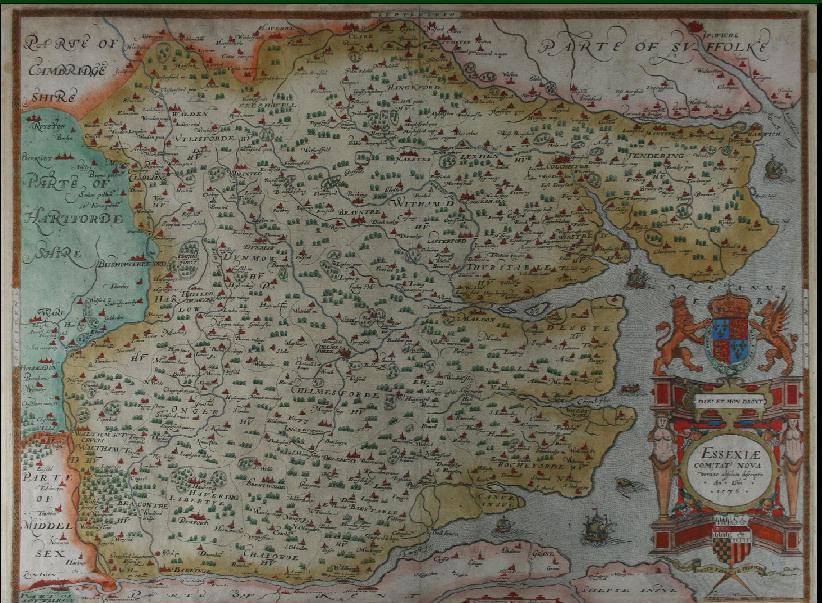Mappy Monday: Tudor maps of sixteenth century Essex
How can contemporary maps help you understand your genealogical or local history research? In this post, I will be considering Christopher Sexton’s 1576 map of Essex(1) and assess its benefit to my historical research on the town of Great Dunmow in the pre-Reformation period. This map was commissioned as part of an atlas of England belonging to William Cecil, Lord Burghley(2), Elizabeth I’s Secretary of State. Click the map below to be taken to the British Library’s zoomable image.
 Christopher Sexton, Essexiae Comitat’ Nova Vera ac Absoluta Descriptio (1576)
Christopher Sexton, Essexiae Comitat’ Nova Vera ac Absoluta Descriptio (1576)
Shelfmark: Royal MS. 18. D.III. ©British Library Board.
Using maps in local history research
Maps may provide not just a town’s geographical infrastructure such as roads and rivers, but also extra detail. For example, Sexton’s map of Essex, with its small pictorial vignette of each church, showed me the precise location of each church in Great Dunmow’s neighbouring villages and towns. Other maps of Essex from a later period give fantastic evidence as to the style, format and floor-plan of the houses depicted. Examine the images of John Walker’s 1591 map of Chelmsford ‘A trew platt of the mannor and towne of Chellmisforde’ and see how each individual house in the town’s centre has been drawn on the map.
Great Dunmow, Sexton’s map and Corpus Christi plays
Great Dunmow’s churchwardens’ accounts documented many neighbouring Essex villages and towns, and even cities such as Cambridge and London. Sexton’s map of Essex helped me track the various locations documented within the accounts and assess the assertions of various historians. In particular, the claims that during Henry VIII’s reign, a band of travelling players toured Great Dunmow’s neighbouring villages to perform plays on Corpus Christi feast-day and then returned home to Great Dunmow each night. Sexton’s map helped me with my hypothesis that this could not have been the case. Rather people from the neighbouring villages travelled into Great Dunmow to witness one central play on one single day.
Corpus Christi was a mid-Summer moveable feast-day that occurred on one given day. The sheer distance between each village, and the number of locations itemised, would have meant that the players would have travelled to a maximum of 16 villages either on one single day or over a period of days. Even if these players had performed in two villages per day, then the plays would have taken more than two weeks to be performed in all the named villages. A two-week festival was hardly in keeping with a single feast-day that took place during the busy agricultural Summer months! Last year, I tried to drive around the 16 villages named by the churchwardens in the 1530-2 accounts as having contributed money towards the feast of Corpus Christi. Even with my super-dupa modern-sports car, I couldn’t drive to all the villages in a single day – let alone setup and perform a religious play!
Even through Sexton’s map was drawn 50 years after the period under my study, having his map has given more credibility to my supposition that neighbouring villagers travelled into Great Dunmow and not vice-versa.
 Villages documented as attending Great Dunmow’s 1530-2 Corpus Christi play
Villages documented as attending Great Dunmow’s 1530-2 Corpus Christi play
 Villages documented as attending Great Dunmow’s 1539-41 Corpus Christi play
Villages documented as attending Great Dunmow’s 1539-41 Corpus Christi play
I would strongly recommend that whenever possible you use contemporary maps when doing any local history research or any genealogical research.
You may also be interested in the following posts:
– Index to each folio in Great Dunmow’s churchwardens’ accounts
Footnotes
1) Christopher Sexton, Essexiae Comitat’ Nova Vera ac Absoluta Descriptio (1576), Shelfmark: Royal MS. 18. D.III. ©British Library Board.
2) William Cecil, 1st Baron Burghley (consulted March 2012)
3) John Walker, A trew platt of the mannor and towne of Chellmisforde, (1591), Essex Record Office, D/DM P1 (consulted online March 2012)
Many of John Walker’s wonderful maps of sixteenth/seventeenth century Essex have been reprinted in the glorious book:-
A.C. Edwards and K.C. Newton, The Walkers of Hanningfield: Surveyors and Mapmakers Extraordinary, (London, 1985). If you are interested in early-modern Essex or early-modern map making, then I thoroughly recommend this book.
*-*-*-*-*-*-*-*-*-*-*-*-*-*-*-*-*
This blog
If you want to read more from my blog, please do subscribe either by using the Subscribe via Email button top right of my blog, or the button at the very bottom. If you’ve enjoyed reading this post, then please do Like it with the Facebook button and/or leave a comment below.
Thank you for reading this post.
You may also be interested in the following
– The craft of being a historian: Research Techniques
– The craft of being a historian: Analysing primary sources
– The craft of being a historian: Using maps for local history
– The craft of being a historian: Online resources
© Essex Voices Past 2012-2013.

Comment (4)
mr. graham pavitt| 1st June 2016
I am trying to purchase saxtons (reproduction) maps. 1 x essex…. 2 x devon. do you know where these can be sourced I tried the british museum where my first maps came from quite a few years ago but it seems they no longer sell them. I would
be grateful for any information you could give me..
The Narrator| 5th October 2016
The Essex map isback on the British Library’s website (as of October 2016). Here’s a link http://prints.bl.uk/art/477440/map-of-essex
Kate
graham pavitt| 6th October 2016
thank you very much for this information
graham pavitt| 6th October 2016
I seem to have once again done something wrong trying to send you a thank you note so on my second attempt THANK YOU for the information